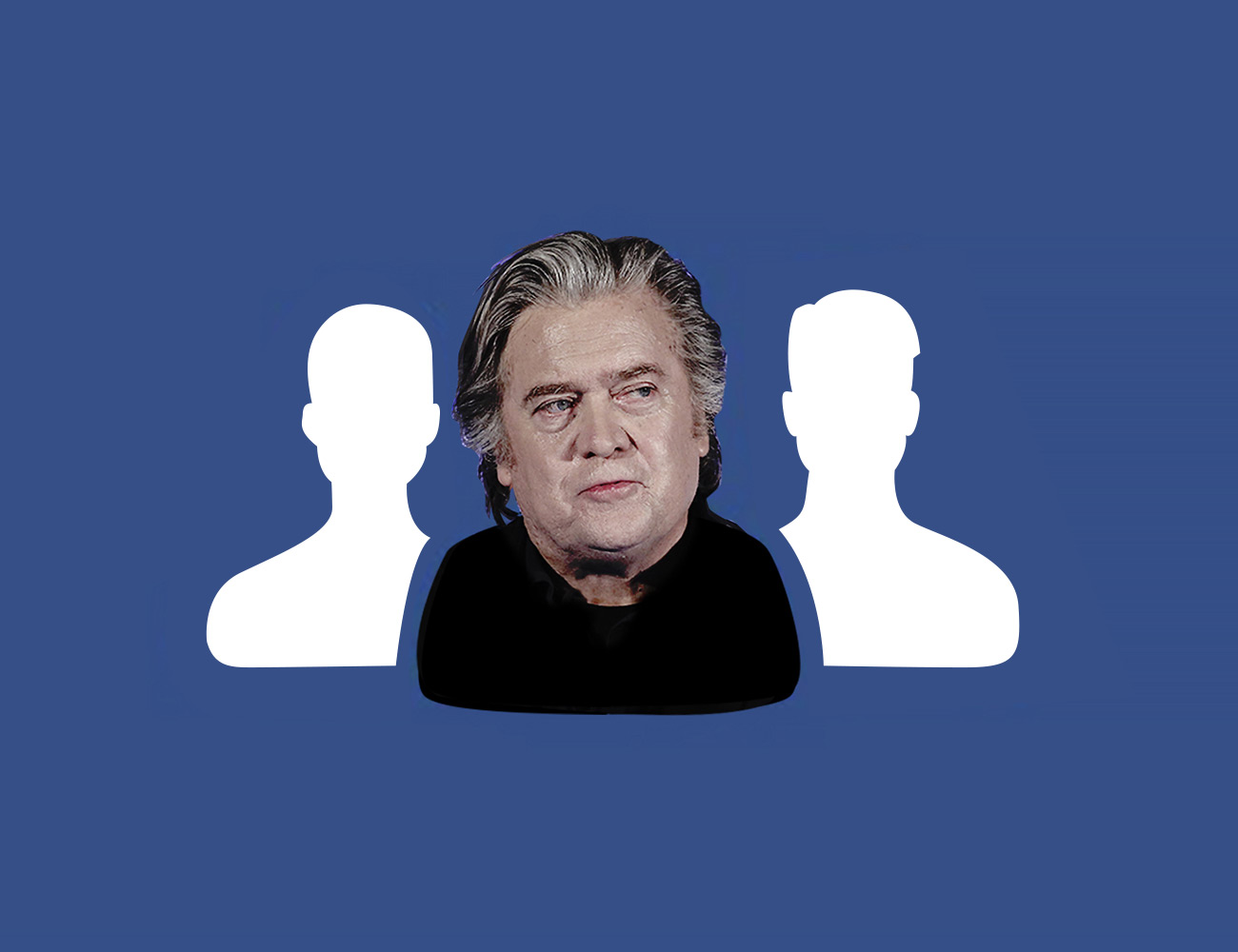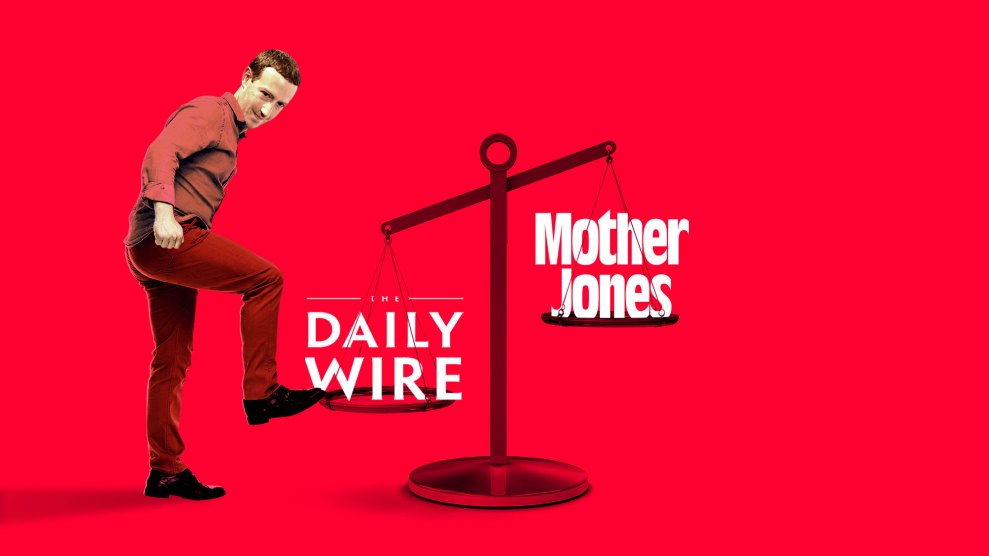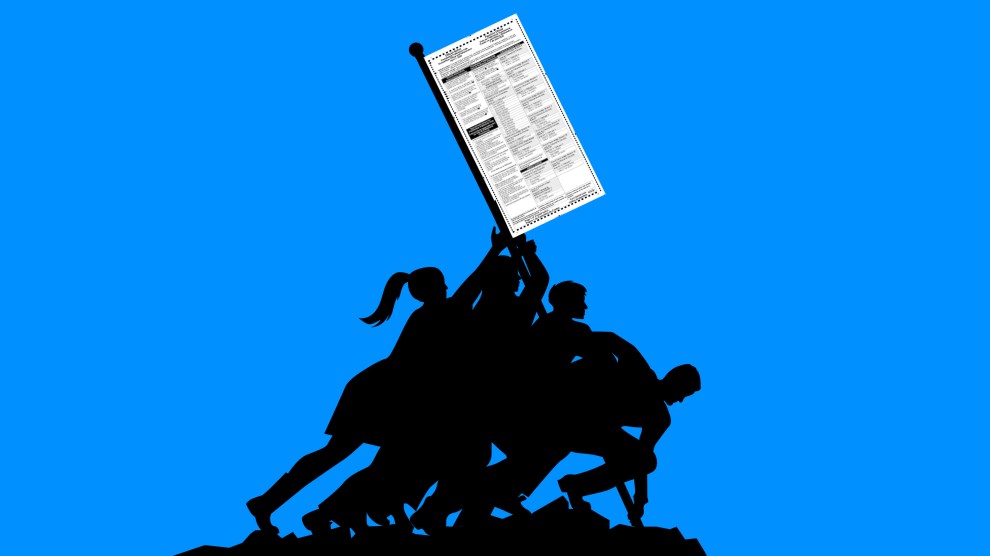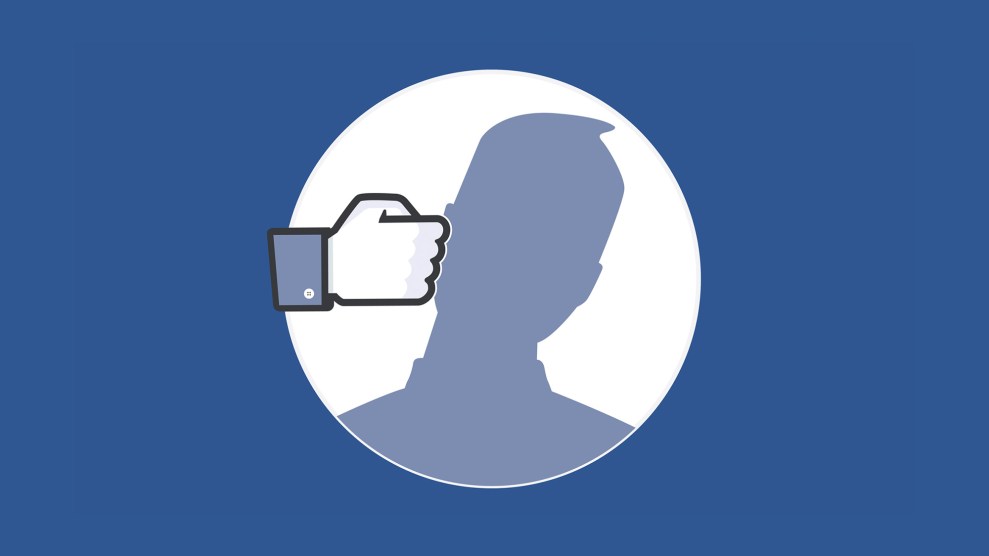Let’s talk about Steve Bannon—I’d like to say “one last time” but who are we kidding? Regardless of the election outcome, we know that America’s political and media ecosystem has been inexorably changed by a racist novel-loving, dual collar-wearing media entrepreneur from Norfolk, Virginia. And if you thought the Bannon story was over after he got booted from the White House, or after he got pushed out of Breitbart News, or after his arrest by Postal Service agents this summer—you were wrong. Like a bad penny, Bannon keeps coming back, and in the closing weeks of this high-stakes election, he has been hauling out all of his old tricks to accomplish one simple goal: Sow chaos and confusion about Joe Biden, by any means necessary.
It was Bannon who shopped dubious material, supposedly off a Hunter Biden laptop, to the New York Post and other news outlets. It was people in Bannon’s circles who have been desperately trying to “pizzagate” Biden with baseless rumors. It is Bannon and Rudy Giuliani who, as my colleagues David Corn and Dan Friedman have comprehensively reported, keep pushing ever thinner and more loathsome allegations to every right-wing outlet site around. And while mainstream media are not being hoodwinked as much as they were in the past, it doesn’t matter as much anymore because it’s easier—and more profitable—than ever to pump propaganda directly into America’s political bloodstream.
What made Bannon so effective over the years is the reengineering of our news ecosystem by tech platforms, most notably Facebook. If Bannon helped make Trump, Facebook helped make Bannon. And even if Bannon were to end up behind bars, and Trump were to be booted out of the Oval, we’ll be living in the world they created for a long, long time.
The seeds for this were sown back in the 1990s, by the most powerful news site of the early years of online publishing, the Drudge Report. Matt Drudge realized that white conservative resentment could be an internet profit center: He repackaged other outlets’ stories under outrage-inducing headlines and sold the hell out of the ensuing web traffic. (Though this year, Trump has become too much even for Drudge.)
Learning at Drudge’s shoulder in those years was a young assistant named Andrew Breitbart, who went on to help Arianna Huffington launch what she intended as Drudge’s liberal counterpart, The Huffington Post. Then Breitbart moved on to start his own site. It was the mid-aughts; social media was blossoming, traditional publishers’ business model was crumbling, and the recession was fueling a toxic mix of economic and racial fears. Breitbart spent the early Obama years peddling birtherism and other conspiracy theories to an angry, white, and largely male audience to whom a Black president felt like an existential threat.
But Breitbart was still a marginal publisher, and Donald Trump a marginal celebrity. Then, however, two critical things happened. In 2012, Andrew Breitbart died and control of the site went to Bannon, who in turn brought in an infusion of capital from hedge-fund billionaire Robert Mercer, (who would also soon invest in a little-known British outfit named Cambridge Analytica).
And, right around the same time, Facebook began tweaking its algorithm—the formula that determines which posts get shown in your personal feed—to include more content from publishers. It aimed, as Mark Zuckerberg would famously say, to be the “perfect personalized newspaper for every person in the world.”
No one back then understood what this meant. In fact, many in the media were excited—Facebook promoting news could only be good for struggling newsrooms. Maybe it was even good for democracy.
But we misunderstood what Zuckerberg meant when he said “news.” He wasn’t talking about journalism, or any verified account of facts. He was talking about content—any content, of any quality. And, given that Facebook was laser-focused on growth, and growth was fueled by sharing, and sharing was fueled by emotion, he was in particular talking about content that riled you up. Content that made you love, but also content that made you hate.
What many of us didn’t know—but Steve Bannon did—was that content that makes you hate is easy to produce, and very clickable and shareable. And so, Breitbart turned the volume up to 11. It launched a vertical literally called “Black Crime.” It gave bylines to extremists and white nationalists. It became, as Bannon would tell Mother Jones as Trump’s 2016 campaign roared ahead, “the platform for the alt-right.”
And soon Breitbart was no longer marginal, nor were the toxic ideas it promoted. Facebook’s algorithm helped it suck millions of Americans into an alternate reality where white people were endangered, immigrants were invaders, a casino developer was the champion of the working class, and any news that did not align with this narrative was fake. (For a while, Breitbart had a section called “Fake News Freakouts” that was entirely about discrediting actual journalism.)
Yet even as he worked to delegitimize traditional media, Bannon also played them like a violin. In 2012, he established a nonprofit organization dedicated to investigating politicians, the Government Accountability Institute. Its president was Peter Schweizer, a conservative researcher who had previously used his platform at the Hoover Institution think tank to feed investigations of politicians to outlets like 60 Minutes and Politico. As Bannon later explained to the Atlantic’s Joshua Green:
“The modern economics of the newsroom don’t support big investigative reporting staffs… You wouldn’t get a Watergate, a Pentagon Papers today, because nobody can afford to let a reporter spend seven months on a story. We can.”
It’s chilling to see how well Bannon diagnosed the problem he himself had been part of creating: The Facebook-fueled traffic machine was great for the kind of fast-and-cheap outrage content that Breitbart cranked out, but it was nowhere near enough to pay for the more time-consuming accountability reporting that news organizations had traditionally done. In the great shrinking of American journalism, investigative teams were often the first to go.
Schweizer used his perch at GAI to research a book about the Clinton Foundation and the largely fake Uranium One scandal. Then he and Bannon shopped embargoed copies to the New York Times and the Washington Post, both of which—entranced by the sexy exclusives—struck deals with GAI and ran major stories based on information in the book. These stories did a lot to establish the Clinton corruption narrative that dominated 2016.
Bannon had hacked the entire media ecosystem. Not only could he pump demagoguery and lies into his America’s bloodstream thanks to Facebook, he could also get it legitimized by mainstream news organizations. Eager to prove their credentials as nonpartisan arbiters, they would launder right-wing propaganda—and, despite some soul-searching, that has kept happening throughout the Trump years. As Washington Post media critic Margaret Sullivan trenchantly noted during January’s impeachment hearings: “In an unceasing effort to be seen as neutral, journalists time after time fell into the trap of presenting facts and lies as roughly equivalent and then blaming political tribalism for not seeming to know the difference.”
And this year, Bannon tried to pull the same gambit again. As Green, the most thorough journalistic chronicler of his media career, has reported, Bannon and Schweizer cranked up the old “but her emails” machine back in 2018:
“Looking ahead to 2020, it wasn’t hard to foresee that a moderate, two-term vice president like Joe Biden, popular across the party, was likely to run for president and be a good bet to win. Nor was it difficult for GAI to turn up examples of ethically questionable behavior by Biden’s family members.”
In 2018, Schweizer published Secret Empires, which laid out Hunter Biden’s business dealings and immediately went into heavy rotation in conservative media—especially Fox News. Before long, the president was tweeting about it, even citing Schweizer as his source, and dispatching Giuliani to go dig for dirt in Ukraine. That quest led directly to that fateful phone call with the Ukrainian prime minister, the impeachment hearings, and, most recently, the right-wing media storm over Hunter Biden’s laptop.
In 2020, Bannon, Schweizer, and Giuliani’s work did not break through into mainstream media as the October Surprise they imagined—or led the president to imagine. But it didn’t matter as much as it once might have. By now, Trump’s campaign strategy was entirely predicated on turning out his base, and the base was getting marinated in disinformation 24/7.
It was also being squeezed for all it was worth. For there’s another piece to the Bannon/Facebook/Trump nexus: Just as with Drudge back in the day, it’s not just about the politics. It’s about profit. Each of those outrage clicks produces revenue for Breitbart and the myriad other right-wing sites, Facebook accounts, and video mills that have sprung up to emulate it. And as audiences get sucked deeper into the fear-and-rage vortex, they also become the perfect mark for old-fashioned grift.
In August, Bannon was arrested in a fraud case (he has pleaded not guilty) involving a crowdfunding effort to build a border wall that pulled in some $25 million in donations. Brian Kolfage, the man at the center of the scheme, allegedly used donations to buy a luxe 40-footer named Warfighter. (Bannon himself was arrested while hanging out on the 152-foot Lady May, owned by a fugitive Chinese businessman.)
The 24-page indictment against Bannon and his alleged co-conspirators lays out just how these wise guys may have thought of their rank-and-file supporters: “Some donors wrote directly to Brian Kolfage,” the indictment notes, “saying that they did not have a lot of money and were skeptical about online fundraising campaigns, but they were giving what they could because they trusted Kolfage would keep his word about how their money would be spent.” Kolfage assured them that he was not taking a penny in compensation, it alleges, even as he and Bannon redirected more than $1 million to accounts they controlled.
GoFundMe eventually took down the We Build The Wall page. But guess who did not? Facebook. And can you guess what that page is doing now? It’s become, in effect, one of the right-wing “news” sites that were so effective in spreading disinformation in the 2016 campaign. (Kolfage himself, prior to We Build the Wall, operated another propaganda page called Right Wing News that was eventually taken down by Facebook. Not for peddling disinformation, though. Just for using fake accounts to gin up traffic.)
You might conclude from this twisted tale that we’re full circle back to 2016—and you wouldn’t be wrong, except for one thing: It’s actually worse. In 2016, Facebook could still claim that the architects of disinformation were manipulating its platform. But now we have evidence that Facebook was actually helping push this propaganda. As Mother Jones editor-in-chief Clara Jeffery and I reported last week, Mark Zuckerberg himself signed off on algorithm changes designed to favor conservative publishers—including, specifically, Breitbart—and throttle serious journalism including, specifically, Mother Jones.
In fact, Facebook has been looking out for Breitbart et al all the way back to 2016 (when Bannon was also the Trump campaign’s CEO), with the company’s lobbyists warning, according to our sources, that “we can’t do a ranking change that would hurt Breitbart, even if that change would make the News Feed better.” As late as last year, when Facebook rolled out its News Tab—designed, as Zuckerberg put it at the time, to be “a place in the Facebook app dedicated solely to high-quality news”—it pointedly included Breitbart.
So it’s not just that conservatives are good at gaming Facebook, Facebook is gaming itself in favor of conservatives—and it’s working. Every day, right-wing sources like Breitbart, The Daily Wire, and Trump himself top the platform’s engagement charts. (The top four highest-engagement posts from the past month are from Trump’s Facebook page; the #3 best-performing post, ironically, was his claim that Facebook and Twitter are censoring conservatives.) When a Republican congressional front-runner shared a video claiming that Jews are using Muslim immigrants to destroy Europe (a theory that Bannon has also embraced), Facebook did nothing except add a pearl-clutching qualifier that the content may be “sensitive to some people.” (The post has now, months later, been removed.) When vigilantes gathered to organize armed patrols in Kenosha, Wisconsin, Facebook did nothing until a teen militant killed two people. And on, and on.
Yes, in recent weeks Facebook has been rolling out a few changes—taking down QAnon groups, banning political advertising immediately after the election, even slowing distribution of the Hunter Biden email story (albeit so clumsily, it ended up boosting claims of censorship). But how are we to believe there’s any kind of principle behind this 11th-hour epiphany? (“It’s interesting to run the simulation of what would happen if Trump were up 10 points right now,” a former Facebook employee told us.)
Facebook made Bannon and Breitbart, and it’s clear that it will enable the next Bannon, the next Breitbart, and the next Trump. It will continue to allow users to be drenched with lies that separate them from their loved ones, their savings, and their own political best interests. It will permit the disinformation machines to keep going, and going.
Unless we break those machines—by building a better model for news. One where stories inspire action, not outrage and hate; where investigations enlighten instead of obfuscating; where opinion pieces advance ideas instead of cementing prejudice. And where publishers approach their audience not as “eyeballs” to be monetized, but as partners.
That’s what we’ve been working to build at Mother Jones ever since we were founded as a reader supported nonprofit, and these past four years you have stepped up in unprecedented ways to help us do it. As we wait out these last few uncertain, anxious days before the election, that fills me resolve. Because no matter what happens on November 3, we know Bannon, Breitbart, and the rest of the propagandists will not be slowing down. Neither will you.
















